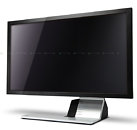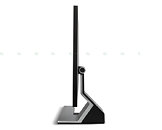Friday, October 23rd 2009

Acer Intros S243HLbmii W-LED Illuminated Display
Acer released its newest PC display, the S243HLbmii. This 24 inch widescreen LCD display sports a futuristic design, and is only 14.5 mm thick. Some of its biggest selling points apart from the design include LED illumination that consumes a mere 17.2W during normal operation, a 65% reduction in energy consumption, compared to LCDs with conventional CFL illumination. The illumination isn't the conventional LED backlit either. The W-LED technology it uses provides a dynamic contrast ratio of 8,000,000:1 (static remains at 1,000:1), with a maximum brightness of 250 cd/m². The native screen resolution is 1920 x 1080, with a response time of 2 ms (GTG). Concealed in the frame, are the two 1W speakers. Display input connectivity includes D-Sub, and two HDMI connectors. It has started selling in Japan for 33,000¥ (240€).
Source:
Akihabara News


41 Comments on Acer Intros S243HLbmii W-LED Illuminated Display
may just be an au thing i guess
Really LED panels are just flat out cheaper to manufacture. Wish I had a patent on them is all.LOL
And even if you do happen to be looking at both dead center, if you can't tell the picture quality difference between a Tn-film and a PVA or IPS, then you are blind.
Another bonus of an led BACKLIGHT is that instead of a solid white plane (as in most modern panels, that results in "glowing" black areas, and hence poor contrast), some manufacturers are now making what is effectively a simple "Black & White" LED backlight screen behind the color screen so that there is only light where there should be (as the backlight screen only displays the brightness pattern of the current frame, instead of displaying the image itself).
Overall this IS a far better idea than just using a plain white backlight, as your image will appear far more balanced, and it helps to expand the effective color tone range of the monitor without having to use more expensive color layers. It's still basically a cheap trick rather than actually producing a proper output medium like OLED, but it can DEFINITELY result in better images.
And before anyone asks what I mean by a "proper" output medium - I mean one where each pixel emits it's OWN light, and there is no backlight at all, rather than the current method whereby all of the pixels are arranged in what is effectively a stained glass window, with a Backlight shining through it from behind.
But they will be replaced eventually.. SED, OLED, some new variant of plasma.. who knows, but the entire concept of a backlight display is a fossil in the making - it will die off soon enough...
i never have understood this bizaare obsesion cclf manufacturers have making them without heatsinks on the output transistors makes no sense :wtf::shadedshu
2. People don't want to burn their eyes. I have my monitor brightness at 37%.
3. Not really. The mixing and diffusion of light requires the screen to be reasonably thick. But LED drivers are much smaller so you do have a point here.16:09 monitors are almost always cheaper than 16:10 ones.
works well, all pluses, no minus
Easiest way to tell is the contrast figures, mines got a ridiculous number of 50,000:1 dynamic and 1,000:1 static - non LED are far lower than that
Still, right now I have a 28", a 24" a 19" and a 15" and no job, I'm not sure I can justify another :rolleyes: